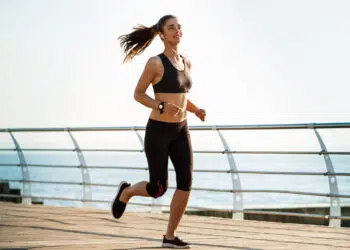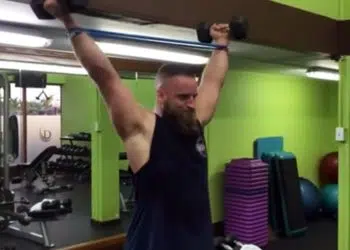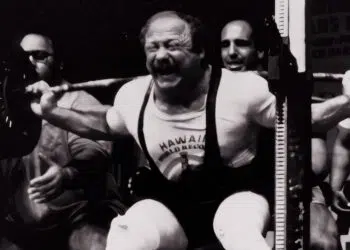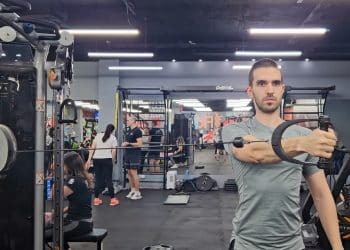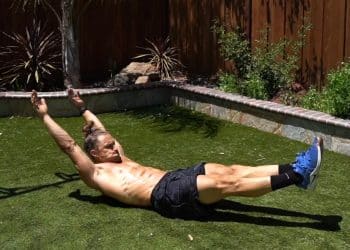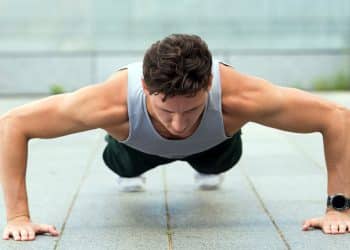If you want the perfect core routine, most experts would agree that you need a hanging ab variation, like wind sprints, for example. Note: Despite what they’re called, wind sprints are not a running activity.
Human legs weigh a lot, and using them as resistance makes sense, because your abdominal muscles function not only to curl the ribcage (like during an ab crunch) but also the pelvis or lower ab area. So when you utilize your lower body, you can get a powerful core workout without needing to use weight.
Plus, more of the extreme leg raise variations would be too difficult to perform using additional weight. And it’s so convenient to have built-in resistance, aka your legs!
Wind sprints require all core muscles including the deeper transverse abdominis to stabilize the spine, while the rectus abdominis curls the pelvis at the lower abdomen. Replicating a pedaling motion keeps the midsection active the whole time.
Keep reading to learn more about the benefits of wind sprints, best variations, muscles, and how to use them in your core training.
Muscles Worked
The hips and core are two of the most important performance muscle groups that allow us to do so many daily tasks and activities. Learning about their anatomy and function will help you to understand why you need to prioritize them in your training regime.
Level Up Your Fitness: Join our 💪 strong community in Fitness Volt Newsletter. Get daily inspiration, expert-backed workouts, nutrition tips, the latest in strength sports, and the support you need to reach your goals. Subscribe for free!

Iliopsoas
Iliopsoas is three hip flexor muscles – the psoas major and minor, and iliacus – that help connect the spine to the lower body. Together, these muscles are the primary hip flexor, allowing us to lift the knee up toward the stomach. Consequently, they’re heavily engaged in wind sprints.
Rectus abdominis
When you perform an ab crunch, it’s the rectus abdominis muscles that allow you to curl your torso using the muscles between the ribcage and pelvis. Wind sprints curl the abdominals near the pelvis end of the torso.
Transverse abdominis
Deeper than rectus abdominis, the deeper transverse abdominis help stabilize the spine similar to a lifting belt. Engaging these muscles prevents too much swinging, but it also helps the movement itself.
Adductor Brevis and longus
Siblings in the thigh adductor muscle family, brevis and longus play similar roles, but to a slightly different extent. As the name suggests, these muscles move the legs inward toward or over each other (e.g., crossing your legs).
Other functions of brevis and longus include outward rotation of the leg, flexing the thigh at the hip, balance, and alignment.
Pectineus
Another name in the adductor group, but unlike brevis and longus, pectineus is a stronger hip flexor than adductor. So while it can help pull the thigh inward, it’s better at assisting in lifting the thigh.
Quadriceps
While they don’t get worked during wind sprints like they would from a squat, quadriceps – five leg muscles at the front of the thigh – are active, and their job is to bend the hip and extend the knee.
Sartorius
The longest muscle we possess, sartorius extends down the length of the inner front thigh, and crosses through both the hip and knee joints. It’s a weak hip and thigh flexor acting more as a synergistic muscle in the upper leg.
Tensor Fasciae Latae
An adductor muscle too, tensor fascia latae (TFL) assists during movement and stabilization of the hips and knees. It works with the gluteus medius and gluteus minimus to internally rotate and abducts the hip.
How To Do Wind Sprints
There’s a right and wrong way to maximize an exercise if your goal is to strengthen and develop a muscle group. Wind sprints are no different. If you want to train the waist, hips and core, then there’s an optimal technique which we’ve detailed below with step-by-step instructions.
Steps
- Stand under a pull-up bar in the center, then reach up and grab it with an overhand grip and your hands slightly wider than shoulder width.
- Pull your scapula down and don’t let your head sink into your shoulders.
- Bend your hips and lift both knees to roughly waist height. Tense your abdominal muscles to stabilize and activate the muscles in the core.
- Now make circular motions with your feet as if you were running or pedaling a bicycle.
Try to aim for a minimum of 15 seconds.
Watch the video example below to see how wind sprints looks in motion.
Tips
- Start small, and work your way up to a longer duration per set.
- It may be better to set a timer than to count reps, if you prefer to focus on the movement rather than counting reps and grinding your teeth from the burn in your core muscles!
- Avoid swinging your body forward, or pulling and pushing against the bar.
- Do not arch your back. Hang straight down with a neutral spine.
This Exercise:
- Target Muscle Group: Waist
- Secondary Muscles: Quadriceps
- Type: Strength
- Mechanics: Isolation
- Equipment: Pull-up bar
- Difficulty: Intermediate
Benefits of Wind Sprints
Hanging from a bar has many benefits on its own, add some hip and leg movement, and you have one of the ultimate movements. Here are the reasons why we like wind sprints… p.s., they won’t make you run faster!
Stronger hip flexors
Hip health and mobility are two factors that contribute largely to quality of life and well-being. Oftentimes we take their function for granted, especially in older age. However, the power of physical exercise has incredible benefits for the body.
Wind sprints are one way to maintain that flexibility and movement in the hip joint, and with much less pressure on the joints.
More capable abdominals
Hanging leg raise variations like wind sprints are some of the best core training you can do. Using your legs as the resistance is a superior form of ab training and everyone should be doing it in some form. After all, we use our own weight to perform many exercises, yet we don’t utilize the legs alone enough!
Work up a sweat!
Not quite as high intensity compared to sprinting or high impact exercise, wind sprints are a cardio-based activity. Everything from using your grip to hang from the bar, keeping your core strong, and moving your legs uses up energy.
Level Up Your Fitness: Join our 💪 strong community in Fitness Volt Newsletter. Get daily inspiration, expert-backed workouts, nutrition tips, the latest in strength sports, and the support you need to reach your goals. Subscribe for free!
The potential benefits of working up a sweat include burning body fat, improving heart health, elevating your mood (can be long term daily if you do it regularly), and keeping away disease.
Better for your joints
Unlike actual sprints that involve a lot of impact, wind sprints are an impact-free activity. The goal isn’t to improve your running speed but to strengthen the core and hip flexors. So it’s a win win!
Drawbacks of wind sprints
Wind sprints are excellent, but not perfect, like almost any exercise. However, the pros outweigh the cons. Here are some potential drawbacks of this exercise.
You need a good grip and total body strength
If you’ve trained, you know that hanging from a bar requires a strong grip. Add in a leg movement, and it becomes even more challenging. Some people may not be able to do wind sprints for long or at all.
Here’s an article with 8 tips to get stronger on the bar!
Requires a bar
While no bar means you cannot do this version of wind sprints, there are variations and alternatives that we highly recommend, and included a little later on in this same wind sprints guide.
Common Mistakes When Performing Wind Sprints
To reap the benefits of wind sprints, try to avoid making these mistakes that’ll reduce their efficacy.
Dropping the knees too low
If you drop the knees, the waist will not get as good a workout and it’ll look like you’re riding a unicycle. That’s the wrong way to do it. Keep a strong 90-degree bend in the hips and fight against the weight of your legs. You want to maintain activation of the waist and assisting muscles like your abs.
Bad hanging technique
Unless you’re hanging to decompress your spine, you want to keep the scapula down and head untucked (not sunk down into your shoulders). This supports proper training posture, and movement efficiency.
Pushing against the bar/pulling up
If you’re inexperienced, you might do things to compensate for a difficult movement. Avoid pushing against the bar or trying to pull yourself. The body should hang straight down, and only the legs should move.
4 Variations and Alternatives of Wind Sprints
Let’s take a look at some of the exercises with similar technique that you can benefit from just as much and more.
Hanging leg raises
If you want to get more core engagement, then take the leg raise higher to intensify the abdominal contraction. You’re now focusing more on the rectus abdominis than the waist, and you’ll benefit from more hypertrophy.
Steps
- Stand under a pull-up bar in the center, then reach up and grasp it with a roughly shoulder width grip. Pull your shoulder blades down and don’t let your head sink into your body.
- Keep your legs straight and together and tense your core.
- Now bend your legs and lift your knees as high as you can while contracting your core muscles and curling your pelvis up and forward. Do not lift your legs to the bar but to parallel or just above.
- Slowly lower your legs and repeat the exercise for the desired number of reps.
Pro tip: Lift your knees higher than your hips for better core activation.
Bicycle crunches
They look simple, but bicycle crunches done right are a crazy good core builder that also promotes more mobile hips. While more of a rotation exercise, the legs follow a similar movement to wind sprints, and they’re totally worth including in your workouts.
Steps
- Lie down on an exercise mat or soft surface.
- Place your fingertips behind your head near your ears and lift your feet about 12 inches off of the floor.
- Then, pull your left knee into your abdominals while twisting your body to the left. Try to touch your left knee and right elbow. Contract your abs during this part of the movement.
- Immediately do the opposite motion with your legs, and rotate to the right.
- Alternate your legs until you’ve completed one set. Rest for 30 seconds, and repeat.
Pro tips:
- Pretend you’re trying to touch your shoulder to the opposite knee. This will ensure that you get optimal trunk rotation, and hence fully stimulate the obliques.
- Make sure to alternate between bent and extended legs, kicking your legs in circles like you’re riding a bicycle.
Scissor kicks
One of the legendary ab exercises, scissor kicks are right up there with bicycle crunches, making your core work for every inch of those six pack gains!
Steps
- Lie on your back with your legs straight and heels touching the floor.
- Slide your hands down under your butt with the palms down.
- Flatten your lower back on the floor and brace your core.
- Lift your legs a few inches off the floor, ideally keeping them straight but you can bend the knees a little.
- Raise one leg until it’s at a roughly 45 to 70 degree angle to the floor.
- Lower it back down and simultaneously lift your opposite leg.
- Repeat the previous steps for the ideal number of reps or time.
Mountain climbers
Sharing some similarities but different in many ways to wind sprints, mountain climbers are a great alternative.
During mountain climber variations, the feet alternate striking the ground which means there’s some impact. Therefore, the legs get more workout and you’ll burn more calories overall. You also have to support your weight using your upper body and leg muscles.
An easier mountain climber exercise is a standing mountain climber variation which is similar to high knee raises. However, with the addition of reaching your arms overhead, which trains coordination and may burn a few extra calories!
Steps
- Start in a high plank/full bodyweight push-up position on your hands and toes with the arms about shoulder width. Keep your body in a straight line from the head to the heels. Your shoulders should be directly over your wrists.
- Tense your core muscles, then bend either knee and bring it in toward your chest. Extend it back out to the starting position.
- Repeat with the other leg and alternate for an equal number of reps per side.
- Start off at a slow pace and then only increase the tempo if you can maintain the same form from setup.
FAQs
What is the main purpose of wind sprints?
To strengthen the waist and surrounding muscles such as the hip flexors, and core. It’s also a heart exercise, improving cardio fitness, and there are other benefits.
What are the best sets and reps for wind sprints?
There’s no straight answer to this because it depends on your goals and experience. It’s also more practical to either set a timer or go until you break good form, so you can focus on engaging your core, rather than counting.
Try to aim for 2-4 sets of 15+ seconds or perform the exercise until you cannot keep your knees up anymore.
What is the best way to include wind sprints in my workouts?
There are a few effective ways to incorporate wind sprints in your training and that we recommend, which include:
- Warmup before leg workout or sports activities
- Part of a core-focused workout session
- Circuit training
- Finisher at the end of a leg workout
Wrapping Up
If you have good shoulders, grip strength and healthy hips, then you should give wind sprints a go. They aren’t just a strength builder for the hips and core, but also a functional exercise with a well-rounded list of benefits. Using the weight of your legs to create movement while engaging the core is one of the best forms of exercise anyone can do.
It’s convenient, challenging, burns calories, and will help you to maintain a healthy body and strong heart. Use this exercise guide to plan and program wind sprints into your training, and reap the rewards.
Interested in measuring your progress? Check out our strength standards for Pull Ups, Scissor Kicks, Mountain Climbers, and more.


